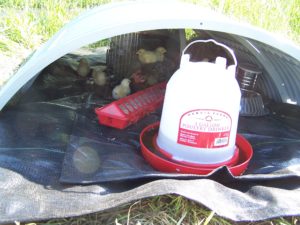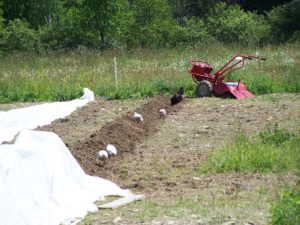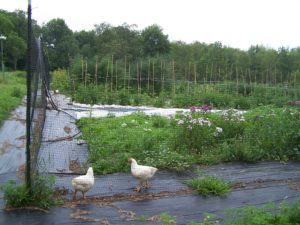Using Foster Mother Hens to Raise Chicks on the “Cheap”
Welcome to the Northeast SARE Spotlight! SARE (Sustainable Agriculture Research and Education) offers grants to farmers, educators, universities and communities that are working to make agriculture more sustainable – economically, environmentally, and socially. Learn about whether a SARE grant would be a good fit for you.
How do you raise chicks without investing in expensive brooder equipment? Drew Piaschyk found success with a clever ruse: he snuck several hens’ eggs away and put the chicks in their place, as if the eggs had hatched overnight. The foster hens protected what they believed to be their new broods, and the Piaschyks saved a vast amount of time and effort—not to mention money, since having the hens take care of the chicks meant they didn’t need to pay for brooder equipment.
With the help of a SARE grant, they carried out a controlled study to see if this trick would work on a larger scale.
Sandy Piaschyk, Drew’s wife, credits her mother with the idea. “I remembered my mother telling me a story where she placed fertile turkey eggs under broody hens and the hens raised the turkey poults as their own,” she says. “We happened to have some hens down for the count on their own eggs and we thought, why not try to get the hens to adopt a ready-made family instead of setting up equipment?”
Both Piaschyks come from farm families. Although Drew didn’t grow up on a farm, his family has been growing vegetables in the Central New York area since the first Piaschyk came here from Poland in the early 1900s. The city of Utica took over Drew’s grandfather’s produce farm in order to build low-income housing, making the family temporarily farm-less until thirty years ago, when Drew and Sandy started Lamb’s Quarters, a 94-acre organic farm in Plymouth, NY. Unlike Drew, Sandy didn’t have to come far to get here–the road they live on was named after Sandy’s grandfather and her family’s farm is right next door to hers.
In order to have an organic farm you need good compost, and the easiest way to make good compost is to have livestock. So the Piaschyks raise goats, sheep, chickens, geese, and guinea hens as well as fruit trees and a vegetable garden. This variety of crops requires constant multitasking. As he speaks about the broody hen project, Drew checks the sunflowers for seed. “They’re just beginning to flower,” he says. Once the flowers produce seeds, Drew can feed them to his livestock.
To raise chicks the standard way, you need a brooder set up in a secure place, away from heavier animals, which could trample the chicks, and vegetables, which the chicks could devour. But making sure the chicks are secure can be very expensive and time-consuming. One day, a hen decided to show up with a group of chicks on the front lawn. Without a brooder or any kind of shelter set up, Drew had to improvise. He grabbed a metal cover from a broken dishwasher and put it in an enclosed garden, where fences shielded his vegetable plantings from hungry deer and raccoons. Not only did the chicks survive—they actually did extremely well. Now, two enclosed gardens serve as home to many of the Piaschyks’ baby chicks.

Chicks learn from their foster mother to eat slugs and other pests in the garden. Courtesy of Elizabeth Rosen.
An added benefit of using foster hens? Pest control. Like most mothers in the animal kingdom, the hens teach their brood how to forage for food. Not only does this reduce the farmer’s feed costs significantly, it also presents an opportunity to get rid of infestations. “One chick saw me turning up soil,” Drew says, “and pretty soon I had three chicks following me around, learning to eat slugs and other pests their mother wasn’t training them to eat.” When two groups of chicks learned about the Japanese beetle infestation in the asparagus patch, Drew went out in the early morning when it was still cold and knocked the beetles onto the ground for the chicks’ breakfast. The birds also seemed to enjoy weed sprouts. Their favorites were chickweed (“Maybe that’s why they call it chickweed,” Drew quips) and lamb’s quarters.
One reason the Piaschyks’ SARE project was so successful may have been that they focused on a very simple idea that was easy to implement. If you’re considering applying for a SARE Farmer grant, think specific rather than large-scale. “The ideas I’ve seen funded are small, practical and can be applied immediately,” Drew says. And whether your project is big or small, be able to explain your expected results. Once you finish the project, you’ll have to do outreach, whether that means giving presentations, writing articles, or reaching out directly to other farmers.
This article discusses SARE grant FNE08-645. To view the final report, visit https://projects.sare.org/sare_project/fne08-645/ For more information, contact Drew Piaschyk at lambsqfarm@frontiernet.net.
Elisabeth Rosen was a summer intern with the Cornell Small Farms Program in 2011.
SARE offers sustainable agriculture grants, bulletins, books, an online events calendar and many other resources. Learn more about the Northeast SARE program by visiting www.nesare.org or by contacting Northeast SARE 655 Spear Street University of Vermont, Burlington VT 05405 Phone (802) 656-0471 Fax (802) 656 -0500 E-mail: nesare@uvm.edu





Hi! I successfully used one of my broody Golden Laced Cochin hens to foster mother three Buff Orpington chicks I got at a local farm store. Even though the chicks were almost two weeks old, they still bonded with their foster mother. This is so much easier than raising chicks in a brooder with a heat lamp and all!
I wrote about my experiences in my blog. I hope it helps someone who is thinking about trying to use a foster hen. It really does work!
http://crossedsabersranch.blogspot.com/2014/03/operation-chicken-little.html
I am using a foster Muskovey hen to HATCH, both, duck and chick eggs. A buff orpington is brooding over 13 of her barn mates’ fertile ones too, while they keep busy producing revenue. Win win win!!!
We are appreciating your post, all information are useful for those who are willing to know about
Scoria Pest Control. Thanks for the information.